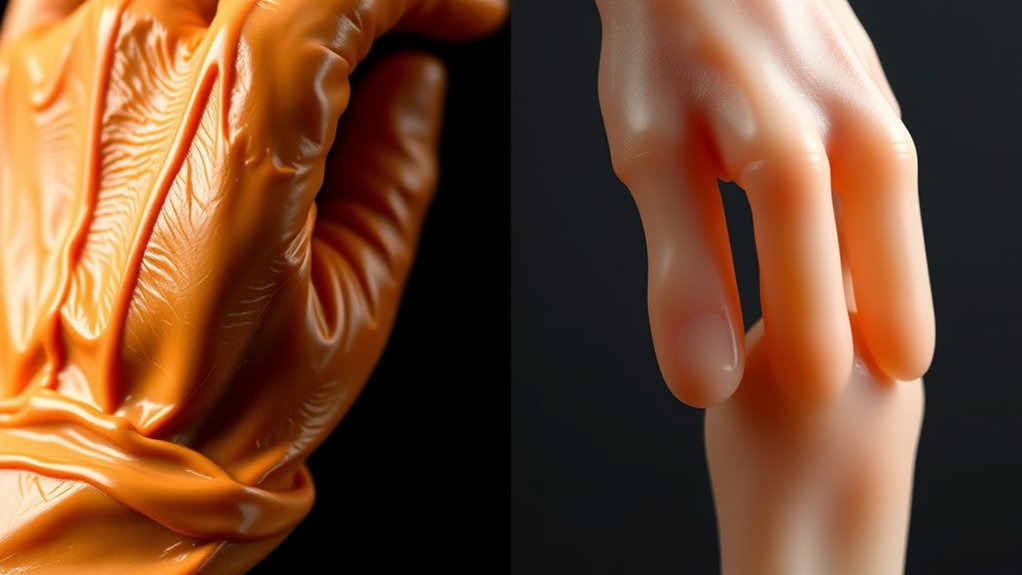When choosing between latex and silicone prosthetics, consider their material features. Latex offers better flexibility, seamless color blending, and a natural feel, but it may cause allergies and degrade quicker. Silicone provides realistic translucency, durability, and better temperature regulation, making it a popular choice for comfort and longevity. Both materials have safety advantages and unique benefits, so weighing your needs carefully can help you decide. Explore further to discover how these options fit your specific application.
Key Takeaways
- Latex offers superior color matching and texture options for realistic aesthetics, while silicone provides translucency and fine skin detail replication.
- Silicone prosthetics are lighter and more durable, with better temperature regulation, enhancing comfort during extended wear.
- Latex tends to be more flexible and resistant to tearing but may degrade faster with exposure to sunlight and chemicals.
- Silicone may experience color fading over time, requiring maintenance, whereas latex generally maintains its appearance longer with proper care.
- Advances in material technology and biocompatibility testing are shaping safer, eco-friendly, and customizable prosthetic options for individual needs.
Material Composition and Manufacturing Processes
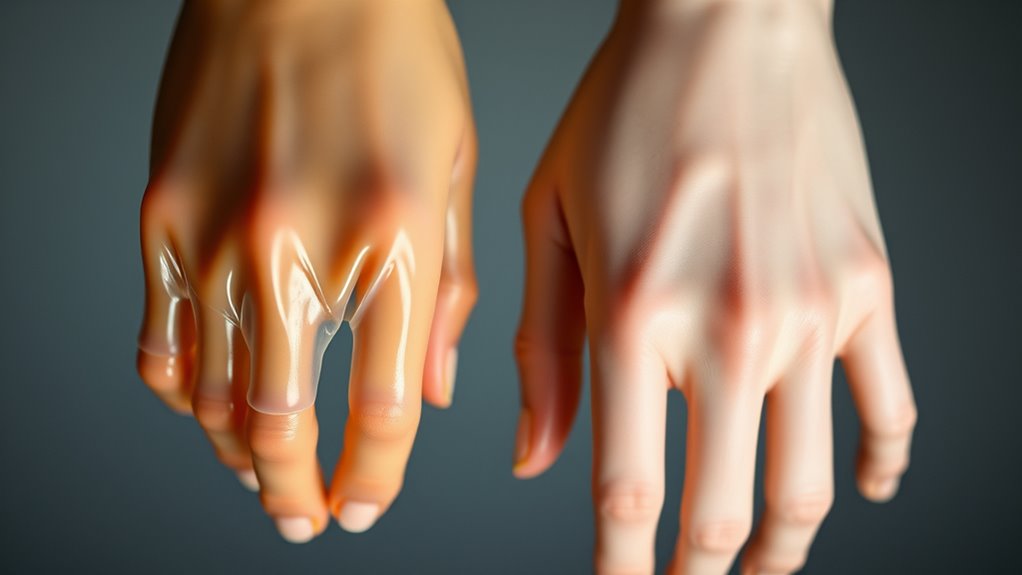
Latex and silicone prosthetics differ markedly in their material composition and manufacturing processes, which directly impact their performance and appearance. Latex is derived from natural rubber, making it more flexible and elastic, but it raises biocompatibility concerns for some users with latex allergies. Its manufacturing involves vulcanization, a process that can produce chemical residues, contributing to environmental impact. Silicone, on the other hand, is a synthetic material made from silica, offering superior durability and a more stable structure. It’s generally more biocompatible, reducing allergy risks. Manufacturing silicone prosthetics involves molding and curing at high temperatures, which tend to have a lower environmental footprint. Additionally, material stability plays a crucial role in determining the longevity and maintenance needs of prosthetics. Overall, both materials have distinct advantages and challenges rooted in their composition and production, influencing their suitability for different users and contexts.
Realism and Aesthetic Appeal
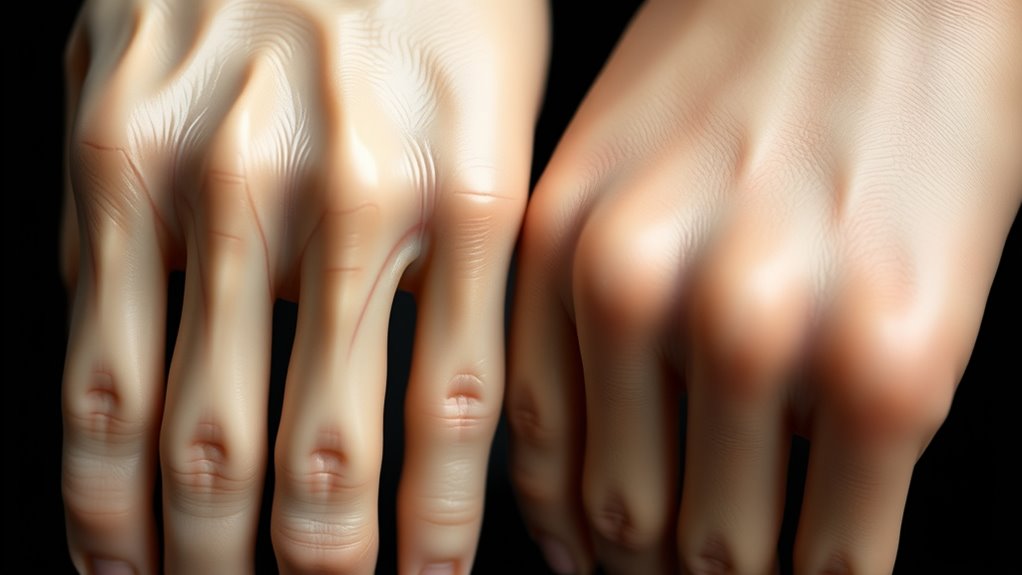
When it comes to achieving a natural look, both latex and silicone prosthetics offer distinct advantages that can influence your choice. Latex prosthetics excel in color matching, allowing artists to blend shades seamlessly for a realistic appearance. They also provide a variety of texture options, from smooth to slightly rough, mimicking skin’s natural feel. Silicone prosthetics, on the other hand, tend to have a more lifelike translucency, giving a subtle glow that enhances realism. Their ability to replicate fine skin details, like veins and pores, makes them highly aesthetic. Additionally, data management plays a role in ensuring the consistent quality and durability of these materials. Ultimately, your decision depends on which qualities matter most—latex’s versatile coloring and textures or silicone’s superior translucency and detail. Both materials can deliver impressive results when crafted with skill.
Comfort and Wearability

Choosing the right prosthetic material substantially impacts your comfort during wear. Both latex and silicone offer different benefits for skin flexibility and temperature regulation, affecting how comfortable you feel throughout the day. Latex tends to be more flexible, allowing for easier movement and a snug fit, which can improve comfort. Silicone, on the other hand, often provides better temperature regulation, helping to prevent overheating. Consider these factors:
- Latex’s superior skin flexibility for a natural feel
- Silicone’s ability to maintain a comfortable temperature
- Breathability differences affecting sweat and moisture
- Fit consistency over extended periods
- Advances in prosthetic material technology are continually improving comfort and usability.
Your choice should focus on how well the material adapts to your skin and daily activities, ensuring maximum wearability without discomfort.
Durability and Longevity
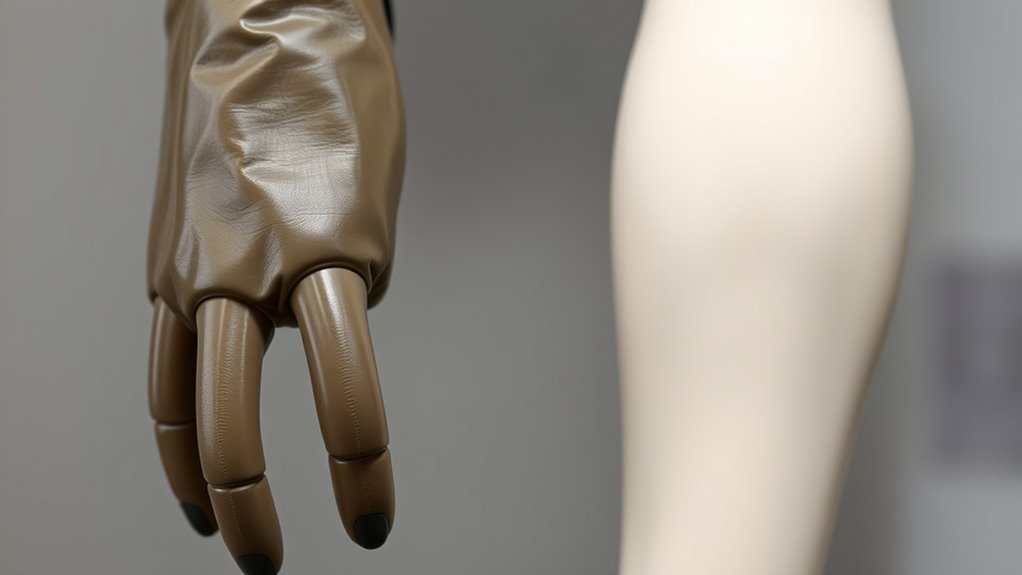
Durability and longevity are critical factors to contemplate when selecting a prosthetic material, as they determine how well your device will hold up over time. Latex prosthetics tend to be more flexible and resistant to tearing, often lasting longer with proper care. Silicone prosthetics, while durable, can be more prone to color matching issues that may fade or discolor over time, affecting their appearance. Weight considerations also come into play; silicone tends to be lighter, reducing strain during extended wear, which can impact long-term comfort. Latex’s durability makes it suitable for active lifestyles, but it may degrade faster if exposed to sunlight or chemicals. Ultimately, your choice should balance durability needs with aesthetic longevity, ensuring your prosthetic remains functional and visually consistent over years of use.
Maintenance and Care Requirements

Proper maintenance is essential to keep your prosthetic functioning well and looking its best. Regular cleaning routines prevent buildup and prolong its lifespan. Be sure to follow manufacturer instructions for cleaning, using gentle soaps and water. Storage tips are equally important; store your prosthetic in a cool, dry place away from direct sunlight to prevent material degradation. To care for latex or silicone prosthetics, consider these points: – Rinse thoroughly after each use – Avoid harsh chemicals or alcohol-based cleaners – Keep away from extreme temperatures – Use a soft cloth to dry gently to ensure longevity and safety.
Cost and Affordability
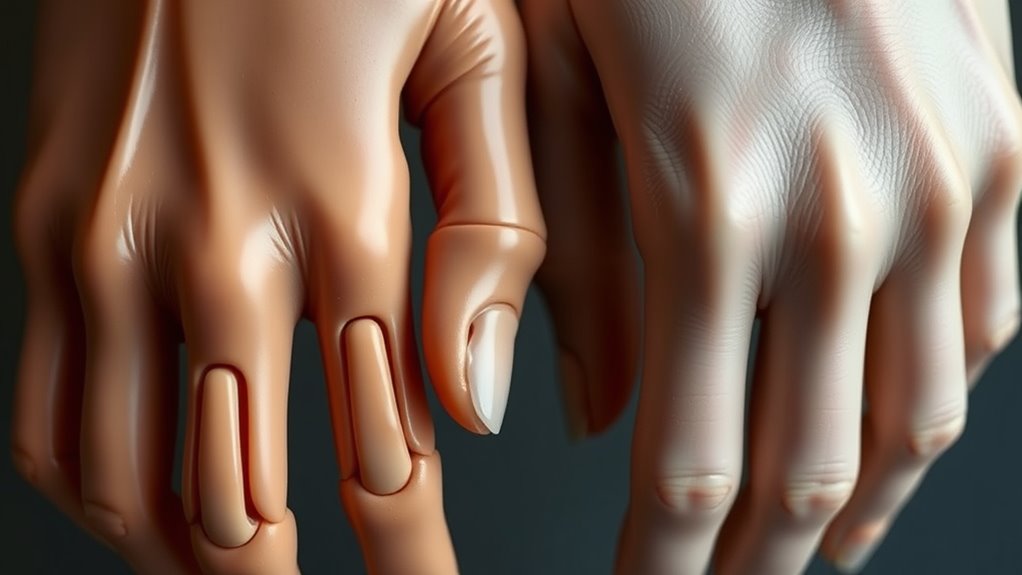
Latex prosthetics tend to be more affordable upfront than silicone options, making them a popular choice for many users. The pricing differences are significant, with latex generally costing less initially. However, it’s essential to contemplate long-term costs, especially since some insurance plans may offer limited coverage for latex prosthetics. Insurance coverage varies widely, and you might find that silicone options, although more expensive initially, could be better covered in the long run due to durability and comfort. When comparing costs, factor in both the initial purchase price and potential ongoing expenses like repairs or replacements. Your choice depends on your budget, insurance benefits, and whether you prioritize affordability or other factors like durability. Additionally, understanding the cost differences between materials can help you make a more informed decision aligned with your financial situation.
Safety and Potential Allergic Reactions

While cost considerations are important, safety and potential allergic reactions also play a significant role in choosing between latex and silicone prosthetics. Latex can cause allergic sensitivities, especially for those with prior sensitivities to natural rubber. Silicone, on the other hand, generally has a lower risk of allergic reactions but isn’t entirely risk-free. Chemical exposure during manufacturing or use may also be a concern. To minimize risks, consider these points:
- Latex contains proteins that can trigger allergies
- Silicone is hypoallergenic but may still cause sensitivities in rare cases
- Chemical residues in either material could lead to irritation
- Testing for allergies before full use is recommended
- Data analytics in AI help identify and mitigate potential health risks associated with materials
Understanding these factors helps you make safer, informed choices.
Suitability for Different Applications
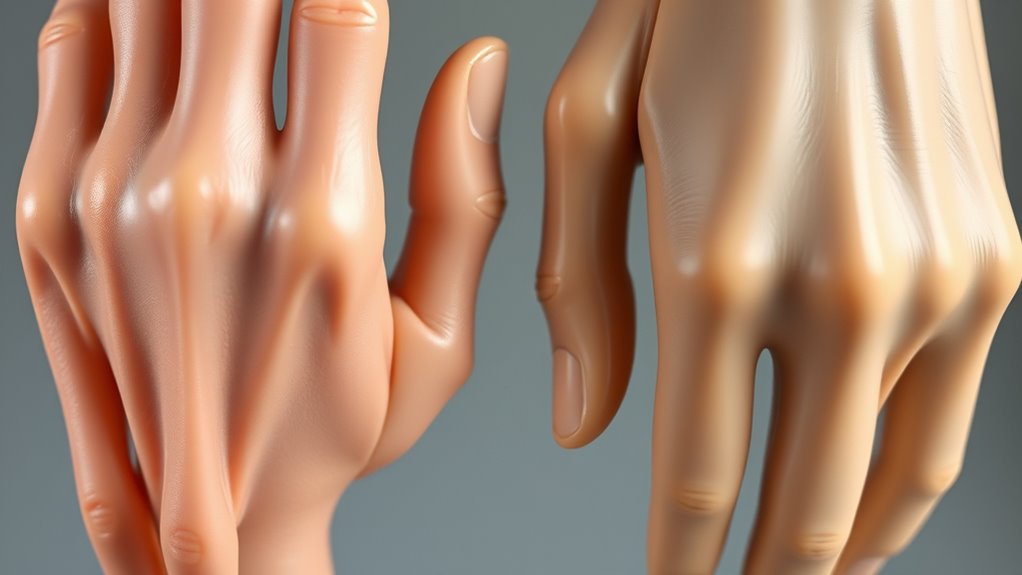
Choosing between latex and silicone prosthetics depends heavily on the specific application. For cosmetic enhancements, silicone is often preferred because it closely mimics natural skin textures and provides a realistic appearance. Its flexibility and ability to hold color make it ideal for facial prosthetics and other visible parts. In sports applications, durability and resistance to wear are critical. Latex prosthetics can be advantageous here because they are lightweight, flexible, and easier to replace or adjust quickly. However, silicone’s resilience to environmental factors like moisture and temperature makes it suitable for prolonged or active use. Ultimately, your choice should align with the prosthetic’s purpose, whether for aesthetic realism or functional performance in active environments. Implementing cost-effective production strategies can help manage expenses when choosing materials.
Advances and Future Trends in Prosthetic Materials
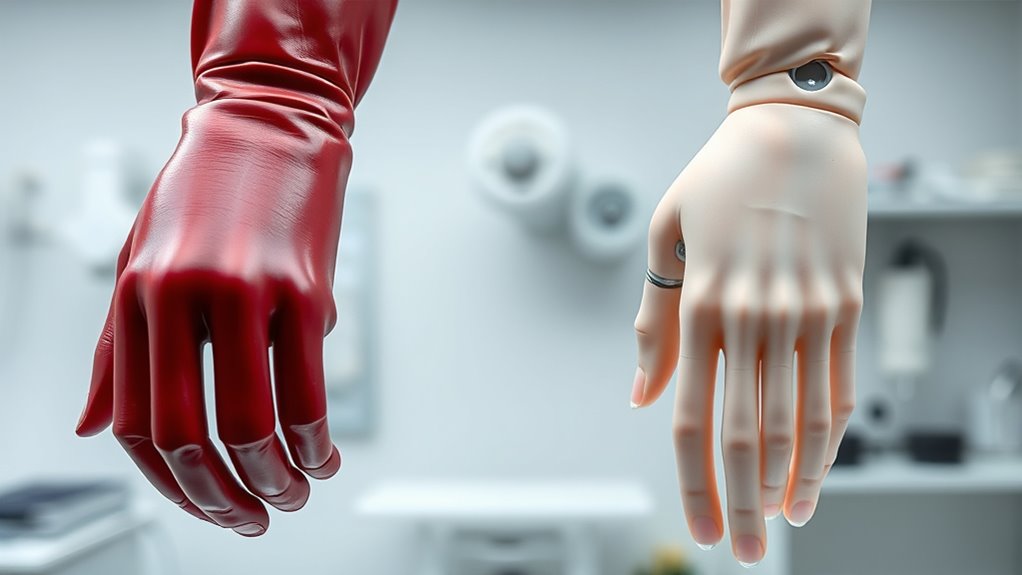
Recent innovations in material technology are transforming how prosthetics are designed and used. Emerging biocompatible options promise greater comfort and durability for users. Exploring these advancements helps you understand what the future holds for prosthetic development. Additionally, researchers are investigating nanotechnology-based materials that could enable even more precise and adaptive prosthetic solutions in the coming years.
Innovations in Material Technology
Advances in material technology are rapidly transforming the landscape of prosthetic development, offering you lighter, more durable, and highly customizable options. Researchers focus on improving biocompatibility testing to ensure safety and reduce allergic reactions, making materials more user-friendly. Additionally, sustainability plays a significant role, with innovations targeting environmental impact through eco-friendly manufacturing processes. You’ll notice developments such as:
- Use of biodegradable and recyclable components
- Enhanced durability with reduced weight
- Increased resistance to wear and environmental factors
- Incorporation of smart materials for adaptive functionalities
These innovations aim to create prosthetics that are not only safer and more sustainable but also tailored to your specific needs, promising a future where prosthetic technology aligns with both health and environmental priorities.
Emerging Biocompatible Options
Innovations in material technology are paving the way for biocompatible options that enhance comfort and safety in prosthetic use. New materials undergo rigorous biocompatibility testing to guarantee they won’t cause adverse reactions. Researchers are focusing on improving material integration, allowing prosthetics to bond more effectively with skin and tissue. Emerging options include bioengineered silicones and advanced polymers that mimic natural tissue properties, reducing irritation and discomfort. These innovations aim to create prosthetics that are more adaptable and durable, aligning closely with your body’s needs. As biocompatibility testing advances, future materials will offer safer, more seamless integration, making prosthetic wear more comfortable and reliable. You can expect these trends to revolutionize prosthetic design, offering personalized solutions tailored to individual sensitivities and lifestyles. Additionally, ongoing research into biocompatibility testing is essential to ensure these new materials are safe for long-term use and compatible with a variety of users.
Frequently Asked Questions
How Do Latex and Silicone Compare in Odor Retention?
You’ll find that latex generally has better odor retention and scent durability than silicone. Latex tends to hold onto smells more, which can be a concern if you need fresh scents daily. Silicone, on the other hand, usually offers easier cleaning and less scent retention over time. So, if odor control is a priority for you, silicone might be the better choice, but latex could require more maintenance to manage scent buildup.
Are There Environmental Impacts Associated With Each Material?
You should consider that latex has a smaller environmental footprint because it’s a natural, biodegradable material, reducing waste. However, it’s often not recyclable, which limits its reuse potential. Silicone, on the other hand, is more durable and can be recycled, lowering its long-term environmental impact. Still, its production consumes more energy. So, your choice impacts both environmental footprint and recycling potential, depending on your priorities.
Which Material Is Easier to Customize for Individual Needs?
You find that silicone prosthetics are like a clay artist’s canvas, offering greater customization flexibility and fitting precision. Silicone molds easily to your unique shape, allowing for detailed adjustments that match your needs perfectly. Latex prosthetics, while more flexible initially, are harder to customize due to their limited ability to hold detailed shaping. With silicone, you gain a prosthetic tailored to you, blending comfort and natural appearance seamlessly.
How Do Latex and Silicone Handle Exposure to Water and Moisture?
You’ll find that silicone handles water and moisture better than latex because of its superior water resistance. Silicone prosthetics resist moisture absorption, making them ideal for daily use, swimming, or humid environments. Latex, on the other hand, absorbs more moisture over time, which can cause deterioration or skin irritation. If water exposure is a concern, silicone proves to be more durable and reliable, ensuring longer-lasting comfort and performance.
Can Users Easily Repair or Modify These Prosthetics at Home?
You can often perform DIY adjustments on latex and silicone prosthetics, thanks to their material flexibility, but it’s tricky. Latex is easier to repair at home with simple glue or patches, while silicone repairs require specialized kits and skills. Keep in mind, DIY modifications might not be perfect and can weaken the prosthetic, so you should consult a professional for major repairs or modifications to ensure safety and longevity.
Conclusion
Choosing between latex and silicone prosthetics depends on understanding your priorities—whether it’s realism, comfort, durability, or cost. Both materials offer unique benefits and challenges, so weigh them carefully. Consider your lifestyle, skin sensitivity, and future needs. Making an informed decision means balancing aesthetics with practicality, comfort with longevity, and affordability with safety. Ultimately, select what aligns best with your goals, because the right prosthetic enhances not just your appearance but your confidence and quality of life.
